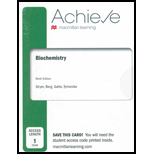
Concept explainers
Interpretation:
Number of NTP molecules used in the conversion of glucose-6-phosphate to glucose is to be determined.
Concept introduction:
Gluconeogenesis is the process of conversion of lactic acid back into glucose. This process uses energy in the form of 6 NTP molecules, hence, it is endogenic in nature. This process is responsible for increasing the blood glucose level when glucose levels fall down in blood.
(b)
Interpretation:
Number of NTP molecules used in conversion of fructose-1,6-bisphosphate to glucose is to be determined.
Concept introduction:
Gluconeogenesis is the process of conversion of lactic acid back into glucose. This process uses energy in the form of 6 NTP molecules, hence, it is endogenic in nature. This process is responsible for increasing the blood glucose level when glucose levels fall down in blood.
(c)
Interpretation:
Number of NTP molecules used in the conversion of two molecules of oxaloacetate to glucose is to be determined.
Concept introduction:
Gluconeogenesis is the process of conversion of lactic acid back into glucose. This process uses energy in the form of 6 NTP molecules, hence, it is endogenic in nature. This process is responsible for increasing the blood glucose level when glucose levels fall down in blood.
(d)
Interpretation:
Number of NTP molecules used in the conversion of two molecules of dihydroxyacetone phosphate to glucose is to be determined.
Concept introduction:
Gluconeogenesis is the process of conversion of lactic acid back into glucose. This process uses energy in the form of 6 NTP molecules, hence, it is endogenic in nature. This process is responsible for increasing the blood glucose level when glucose levels fall down in blood.
Want to see the full answer?
Check out a sample textbook solution
Chapter 16 Solutions
BIOCHEMISTRY-ACHIEVE (1 TERM)
- In the structures below circle and label the beta-D-glucose unit and the chlorine unitarrow_forwarda. What is the name of metabolite 1? b. What is the name of metabolite 2? c. What kind of reaction occurred when 1 was converted to 2? d. What general kind of enzyme might you expect to perform this reaction? e. What cofactor, if any, would be required for this reaction?arrow_forwardWhich of the following homopolysaccharides produced by a plant cell contains only -1,4-glycosidicbonds between glucose monosaccharides (easily digested by most animal species)?A. amylopectin (produced by potato cells)B. amylose (produced by rice cells)C. glycogen (produced by liver cells)D. chitin (produced by fungal cells)E. cellulose (produced by corn cells)arrow_forward
- Nonearrow_forward1. Lectins are ______. (Explain your answer in 1-3 sentences.) A. sugars specific to proteins B. proteins specific to sugars C. enzymes specific to carbohydrates. D. carbohydrates specific to enzymes. 2. Which of the following is a keto triose? (Explain your answer in 1-3 sentences.) A. dihydroxyacetone B. glyceraldehyde C. ribulose D. erythrosearrow_forward1. The following unsaturated fatty acids can be found in seminal fluid and act on smooth muscles. a.Linoleic acids b.Oleic acids c.Prostaglandins d.Nervonic acids 2. The process involved when fatty acid chains covalently bonded to a glycerol molecule through an ester linkage is? a.hydrolysis b.oxidation c.phosphorylation d.esterificationarrow_forward
- In class, I mentioned that fructose is metabolized differently in the liver compared to glucose. Refer to the figure shown below to calculate the number ofATPs you would expect from the metabolism of fructose in the liver. Show your work! Fructokinase Fructose Fructose-1-P АТР ADP Aldolase B Dihydroxy- acetone phosphate Glyceraldehyde АТР Triose kinase Triose phosphate isomerase ADP 4 - Glyceraldehyde-3-P Glycolysis Руruvate Acetyl-CoA Fatty acids and triglyceridesarrow_forwarda. Draw b furanose b. A polysaccharide which is a major constituent in the exoskeleton of arthropods and the cell walls of fungi. c. D-allose is C-3 (Carbon-3) epimer of D- glucose. DRAW D- allosearrow_forwardCHOOSE THE CORRECT LETTER 1.What is the reason for isomerization of citrate to isocitrate?A.The reaction converts a tertiary alcohol, which cannot easily be oxidized, to a secondary alcohol that can be oxidizB. Isocitrate protects cells from the toxic effects of arsenite ion.C. The reaction is one major regulatory step for the citric acid cycle because it functions as a rate limiting step.D. Isocitrate is a substrate for a reaction that occurs spontaneously without enzymatic catalysis 2.Which of the following molecules is NOT involved in the cycle of B-oxidation?A. coenzyme AB. B-hydroxybutyrateC. B-ketoacyl-CoAD. acetyl-CoAarrow_forward
- Arrange the attached image.arrow_forward4. Which among the given peptides will form hydrogen bond with another similar peptide chain? i. ASTGHASTGH ii. GASTHASTCH A. i B. ii C. i & iiarrow_forward4. Consider the structure shown below. Give one cycle of the reactions of the - oxidation of fatty acids. Show all the structures of the compounds involved; indicate whether the reactions are reversible or not; show the use or generation of co-factors wherever it occurs.arrow_forward
 Biology: The Dynamic Science (MindTap Course List)BiologyISBN:9781305389892Author:Peter J. Russell, Paul E. Hertz, Beverly McMillanPublisher:Cengage Learning
Biology: The Dynamic Science (MindTap Course List)BiologyISBN:9781305389892Author:Peter J. Russell, Paul E. Hertz, Beverly McMillanPublisher:Cengage Learning BiochemistryBiochemistryISBN:9781305577206Author:Reginald H. Garrett, Charles M. GrishamPublisher:Cengage Learning
BiochemistryBiochemistryISBN:9781305577206Author:Reginald H. Garrett, Charles M. GrishamPublisher:Cengage Learning

